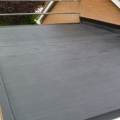Author: Gallagher Fluid Seals
So far on this blog we’ve discussed O-Ring material and sizes, and the ways in which they can be used.
In this post, we’ll talk about the common types of O-Ring applications, and their impact on O-ring sizing and hardware design.
- Static Axial Seals
When designing grooves for static axial seals, the first consideration is whether the pressure is coming from inward or outward.
In situations involving outward pressure, the outside diameter of the groove is primary, and the groove width is the primary consideration for the inside diameter. For inward pressure, the inside diameter is primary. This ensures that the O-Ring needs to move the least distance to seal the extrusion gap.
Inside the groove dimension appendix in our O-Ring guide, you’ll find two charts for static axial seals: one for liquids and one for gases and vacuums. Grooves for liquid applications are larger to allow for increased swell. If there are no anticipated swelling issues, the smaller groove dimension can be utilized.
- Reciprocating Dynamic Seals
O-Rings are used within dynamic reciprocating applications, usually hydraulic or pneumatic piston or rod seals. For short stroke applications, smaller diameter O-Rings perform well. Longer stroke applications require thicker cross sectional O-Rings.
A number of failure modes arise within dynamic sealing applications that are no problem for static O-Rings, a topic we’ll explore in a future blog post.
Surface finishes for the hardware are critical to maximizing seal life and performance. The ideal surface microfinish is between 10 and 20 micro-inches. Anything under five will cause inherent surface lubrication to be wiped away by the end of the stroke. For more information on the types of friction seen in reciprocating applications, please contact a Gallagher engineer.
- Rotary Seals
O-Rings have proven to be reliable rotary seals under the proper conditions. Adequate durometer, hardware configuration and feet-per-minute values must be matched to the proper O-Ring compound. A shaft hardness value of 55 Rockwell is typically required for a successful rotary O-Ring. There are a handful of specialized O-Ring compounds designed for rotary service.
Contact a Gallagher engineer to learn more about these applications, or for any other questions you have about O-Rings.
You can also download our O-Ring design guide, which features information on their discusses their technical performance characteristics, materials, chemical and temperature compatibility, and more.







Recent Comments